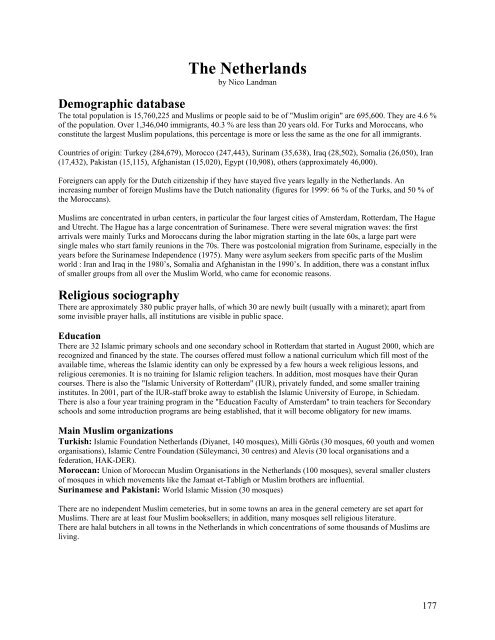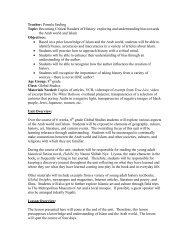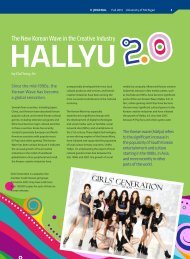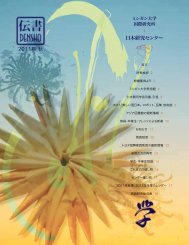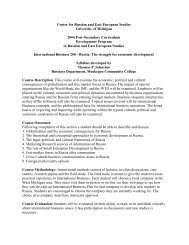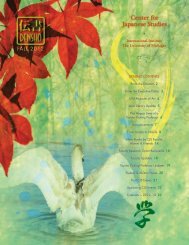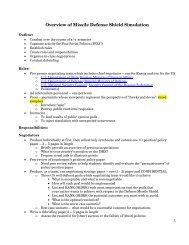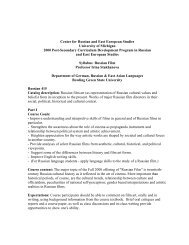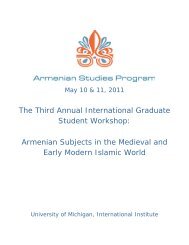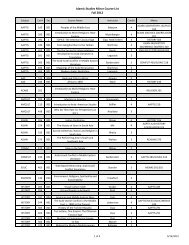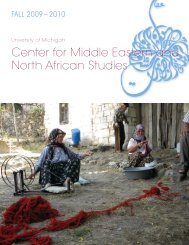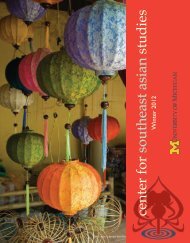Muslims in Europe: - International Institute - University of Michigan
Muslims in Europe: - International Institute - University of Michigan
Muslims in Europe: - International Institute - University of Michigan
Create successful ePaper yourself
Turn your PDF publications into a flip-book with our unique Google optimized e-Paper software.
The Netherlands<br />
by Nico Landman<br />
Demographic database<br />
The total population is 15,760,225 and <strong>Muslims</strong> or people said to be <strong>of</strong> "Muslim orig<strong>in</strong>" are 695,600. They are 4.6 %<br />
<strong>of</strong> the population. Over 1,346,040 immigrants, 40.3 % are less than 20 years old. For Turks and Moroccans, who<br />
constitute the largest Muslim populations, this percentage is more or less the same as the one for all immigrants.<br />
Countries <strong>of</strong> orig<strong>in</strong>: Turkey (284,679), Morocco (247,443), Sur<strong>in</strong>am (35,638), Iraq (28,502), Somalia (26,050), Iran<br />
(17,432), Pakistan (15,115), Afghanistan (15,020), Egypt (10,908), others (approximately 46,000).<br />
Foreigners can apply for the Dutch citizenship if they have stayed five years legally <strong>in</strong> the Netherlands. An<br />
<strong>in</strong>creas<strong>in</strong>g number <strong>of</strong> foreign <strong>Muslims</strong> have the Dutch nationality (figures for 1999: 66 % <strong>of</strong> the Turks, and 50 % <strong>of</strong><br />
the Moroccans).<br />
<strong>Muslims</strong> are concentrated <strong>in</strong> urban centers, <strong>in</strong> particular the four largest cities <strong>of</strong> Amsterdam, Rotterdam, The Hague<br />
and Utrecht. The Hague has a large concentration <strong>of</strong> Sur<strong>in</strong>amese. There were several migration waves: the first<br />
arrivals were ma<strong>in</strong>ly Turks and Moroccans dur<strong>in</strong>g the labor migration start<strong>in</strong>g <strong>in</strong> the late 60s, a large part were<br />
s<strong>in</strong>gle males who start family reunions <strong>in</strong> the 70s. There was postcolonial migration from Sur<strong>in</strong>ame, especially <strong>in</strong> the<br />
years before the Sur<strong>in</strong>amese Independence (1975). Many were asylum seekers from specific parts <strong>of</strong> the Muslim<br />
world : Iran and Iraq <strong>in</strong> the 1980’s, Somalia and Afghanistan <strong>in</strong> the 1990’s. In addition, there was a constant <strong>in</strong>flux<br />
<strong>of</strong> smaller groups from all over the Muslim World, who came for economic reasons.<br />
Religious sociography<br />
There are approximately 380 public prayer halls, <strong>of</strong> which 30 are newly built (usually with a m<strong>in</strong>aret); apart from<br />
some <strong>in</strong>visible prayer halls, all <strong>in</strong>stitutions are visible <strong>in</strong> public space.<br />
Education<br />
There are 32 Islamic primary schools and one secondary school <strong>in</strong> Rotterdam that started <strong>in</strong> August 2000, which are<br />
recognized and f<strong>in</strong>anced by the state. The courses <strong>of</strong>fered must follow a national curriculum which fill most <strong>of</strong> the<br />
available time, whereas the Islamic identity can only be expressed by a few hours a week religious lessons, and<br />
religious ceremonies. It is no tra<strong>in</strong><strong>in</strong>g for Islamic religion teachers. In addition, most mosques have their Quran<br />
courses. There is also the "Islamic <strong>University</strong> <strong>of</strong> Rotterdam" (IUR), privately funded, and some smaller tra<strong>in</strong><strong>in</strong>g<br />
<strong>in</strong>stitutes. In 2001, part <strong>of</strong> the IUR-staff broke away to establish the Islamic <strong>University</strong> <strong>of</strong> <strong>Europe</strong>, <strong>in</strong> Schiedam.<br />
There is also a four year tra<strong>in</strong><strong>in</strong>g program <strong>in</strong> the "Education Faculty <strong>of</strong> Amsterdam" to tra<strong>in</strong> teachers for Secondary<br />
schools and some <strong>in</strong>troduction programs are be<strong>in</strong>g established, that it will become obligatory for new imams.<br />
Ma<strong>in</strong> Muslim organizations<br />
Turkish: Islamic Foundation Netherlands (Diyanet, 140 mosques), Milli Görüs (30 mosques, 60 youth and women<br />
organisations), Islamic Centre Foundation (Süleymanci, 30 centres) and Alevis (30 local organisations and a<br />
federation, HAK-DER).<br />
Moroccan: Union <strong>of</strong> Moroccan Muslim Organisations <strong>in</strong> the Netherlands (100 mosques), several smaller clusters<br />
<strong>of</strong> mosques <strong>in</strong> which movements like the Jamaat et-Tabligh or Muslim brothers are <strong>in</strong>fluential.<br />
Sur<strong>in</strong>amese and Pakistani: World Islamic Mission (30 mosques)<br />
There are no <strong>in</strong>dependent Muslim cemeteries, but <strong>in</strong> some towns an area <strong>in</strong> the general cemetery are set apart for<br />
<strong>Muslims</strong>. There are at least four Muslim booksellers; <strong>in</strong> addition, many mosques sell religious literature.<br />
There are halal butchers <strong>in</strong> all towns <strong>in</strong> the Netherlands <strong>in</strong> which concentrations <strong>of</strong> some thousands <strong>of</strong> <strong>Muslims</strong> are<br />
liv<strong>in</strong>g.<br />
177


